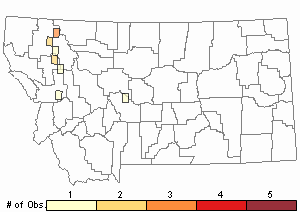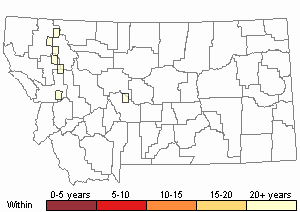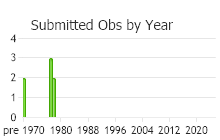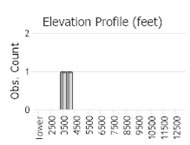View in other NatureServe Network Field Guides
NatureServe
Montana
Utah
Wyoming
Idaho
Wisconsin
British Columbia
South Carolina
Yukon
California
New York
Electric Eels - Dicranum polysetum
Other Names:
Waxyleaf Moss
General Description
Plants: Acrocarpous. Growing in open clumps of erect shoots, shiny, pale green. Stems 0.4-1.5 dm tall; rhizoids thickly covering the stem in reddish or nearly white woolly matting (FNA 2007).
Leaves: Upright (FNA 2007) or typically spreading to widely so; very crumpled or wavy crosswise to the leaf (FNA 2007; Vitt 1988), a little bent and twisted, similar in wet and dry conditions, 5.5-10.5 mm in length, 1-2 mm in width, lance-shaped, cupped, keeled distally (FNA 2007) and a little pleated below (Lawton 1971); leaf edges strongly dentate above, folded up and inward a little proximally (Lawton 1971); costa subpercurrent, with 2 dorsal crests of teeth above (FNA 2007) reaching from ca mid-leaf to the apex (Lawton 1971).
Leaf Cells: Lamina 1 cell-layer thick, the cells smooth, and the walls between cells not bulging; upper laminal cells wavy and porose; lower laminal cells longer than those distally, porose; alar cells distinct, inflated, not reaching the costa, the alar region 2 cell-layers thick; costa in X-section with guide cells in 1 row, ventral and dorsal stereid bands (FNA 2007) in the lower part of the leaf (Lawton 1971), the ventral superficial cells not distinct, the dorsal epidermal layer with a few cells larger than the adjacent stereids (FNA 2007).
Phenology
Fruit ripens in spring (FNA 2007).
Diagnostic Characteristics
One of largest Dicranum species, its branches appear thick from the numerous rhizoids. It also stands out with its broadly spreading, very wavy leaves with the conspicuous teeth above, and the aggregate of sporophytes (FNA 2007).
The similar Dicranum undulatum lacks ridges on its dorsal costal surface whereas D. polysetum has two ridges. Also, D. undulatum is found more often in organic soils of fens and bogs; D. polysetum is more characteristic of upland, northern coniferous forests of the mountains (Vitt 1988), and only occasionally in bogs (Lawton 1971).
Range Comments
North American Range
Seldom growing west of the Rocky Mountains. Canada: YT and BC e to NL and NS; USA: AK, and from the northern continental boundary s to OR, ID, CO, SD, MO, TN and NC (FNA 2007). Known in Montana from Carter, Flathead, Lake, Lincoln, and Missoula (Elliott 2016).
Observations in Montana Natural Heritage Program Database
Number of Observations: 12
(Click on the following maps and charts to see full sized version)
Map Help and Descriptions
Relative Density

Recency



 (Observations spanning multiple months or years are excluded from time charts)
(Observations spanning multiple months or years are excluded from time charts)
Habitat
Soil or (frequently) humus overlying stone, rotting wood (FNA 2007), sometimes bogs (Lawton 1971); coniferous woods, less frequently deciduous forests. Elevation: 30-6890 feet (FNA 2007).
Reproductive Characteristics
Small males growing on female plant rhizoids. Inner perichaetial bracts enveloping the stem, suddenly narrowing to the long acumen. Seta typically 3-6 in a perichaetium, somewhat russet in color, 15-40 mm tall. Capsule bowed, tilted to level, grooved when dry, yellow with red or brown tones, 2-3.5 mm in length; peristome of 16 teeth, separated ca halfway down into 2 lobes (seldom 3), russet, with papillae above. Calyptra hood-like, hairless, sheltering much of the capsule, falling away easily (FNA 2007).
Stewardship Responsibility
References
- Literature Cited AboveLegend:
 View Online Publication
View Online Publication Elliott, J.C. and A.K. Pipp. 2018. A Checklist of Montana Mosses (1880-2018). Updated 3 January, 2020. Montana Natural Heritage Program, Helena, Montana. 73 pp.
Elliott, J.C. and A.K. Pipp. 2018. A Checklist of Montana Mosses (1880-2018). Updated 3 January, 2020. Montana Natural Heritage Program, Helena, Montana. 73 pp. Flora of North America Editorial Committee, eds. 2007. Flora of North America North of Mexico. Volume 27. Bryophytes: Mosses, Part 1. Oxford University Press, Inc., NY. xxi + 713 pp.
Flora of North America Editorial Committee, eds. 2007. Flora of North America North of Mexico. Volume 27. Bryophytes: Mosses, Part 1. Oxford University Press, Inc., NY. xxi + 713 pp. Lawton, E. 1971. Moss Flora of the Pacific Northwest. Hattori Botanical Laboratory. Japan: Yamabuki-cho, Shinjuku-ku, Tokyo. 362 pages plus appendices.
Lawton, E. 1971. Moss Flora of the Pacific Northwest. Hattori Botanical Laboratory. Japan: Yamabuki-cho, Shinjuku-ku, Tokyo. 362 pages plus appendices. Vitt, D. J. Marsh, and R. Bovey. 1988. Mosses, Lichens & Ferns of Northwest North America. Seattle, WA: University of Washington Press. 296 p.
Vitt, D. J. Marsh, and R. Bovey. 1988. Mosses, Lichens & Ferns of Northwest North America. Seattle, WA: University of Washington Press. 296 p.
- Additional ReferencesLegend:
 View Online Publication
View Online Publication
Do you know of a citation we're missing? Crum, H.A. and L.E. Anderson. 1981. Mosses of Eastern North America. 2 volumes. Columbia University Press, New York. 1328 pp.
Crum, H.A. and L.E. Anderson. 1981. Mosses of Eastern North America. 2 volumes. Columbia University Press, New York. 1328 pp. Elliot, J. C. 1993. Second checklist of Montana mosses. Unpublished report. U.S. Forest Service, Region 1. Missoula, MT. 45 pp.
Elliot, J. C. 1993. Second checklist of Montana mosses. Unpublished report. U.S. Forest Service, Region 1. Missoula, MT. 45 pp. Lawton, E. 1971. Keys for the Identification of the Mosses on the Pacific Northwest. Reprinted from 'Moss Flora of the Pacific Northwest'. Published as Supplement No. 2 of the Journal of the Hattori Botanical Laboratory. Nichinan, Miyazaki, Japan. 66 pp.
Lawton, E. 1971. Keys for the Identification of the Mosses on the Pacific Northwest. Reprinted from 'Moss Flora of the Pacific Northwest'. Published as Supplement No. 2 of the Journal of the Hattori Botanical Laboratory. Nichinan, Miyazaki, Japan. 66 pp.
- Web Search Engines for Articles on "Electric Eels"





